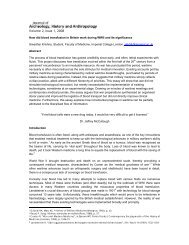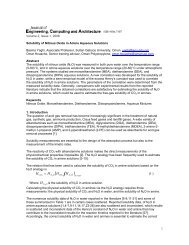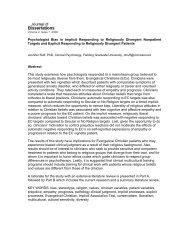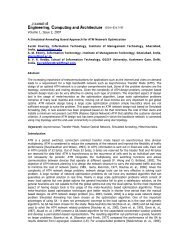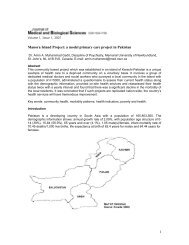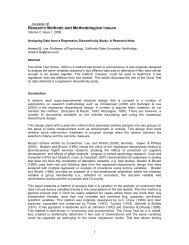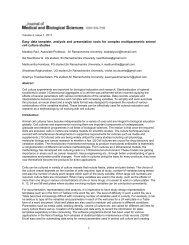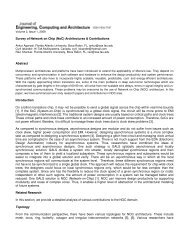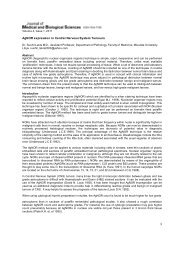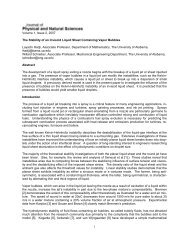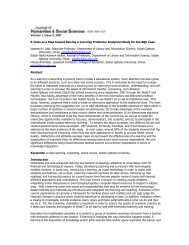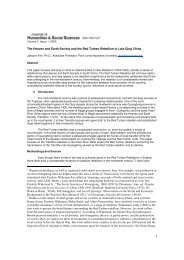Concentration and Speciation of Arsenic in South African Soil ...
Concentration and Speciation of Arsenic in South African Soil ...
Concentration and Speciation of Arsenic in South African Soil ...
Create successful ePaper yourself
Turn your PDF publications into a flip-book with our unique Google optimized e-Paper software.
contam<strong>in</strong>ated areas <strong>in</strong>to water resources) <strong>and</strong> bioavailability <strong>of</strong> arsenic at these sites. Such data<br />
are helpful <strong>in</strong> develop<strong>in</strong>g strategies to manage risks associated with arsenic contam<strong>in</strong>ated soil.<br />
Determ<strong>in</strong>ation <strong>of</strong> total metal concentration is important, but it does not differentiate between<br />
different metallic species, forms or phases; which determ<strong>in</strong>e the potential mobility <strong>and</strong><br />
bioavailability <strong>of</strong> the metal. A comprehensive knowledge <strong>of</strong> <strong>in</strong>teraction between the different<br />
species <strong>of</strong> the metal <strong>and</strong> environmental media such as soil is <strong>of</strong> importance <strong>in</strong> order to be able<br />
to predict their environmental impact. Sequential extraction techniques have been used to<br />
determ<strong>in</strong>e the concentration <strong>and</strong> the different species <strong>of</strong> arsenic <strong>and</strong> other elements <strong>in</strong> soil,<br />
sediment <strong>and</strong> street dust [6, 7, 11, 18, 20]. These studies attest that sequential extraction is<br />
still a much used extraction technique <strong>in</strong> elemental fractionation studies.<br />
This study was conducted to establish the arsenic concentration <strong>in</strong> the soil <strong>and</strong> to assess the<br />
speciation <strong>of</strong> arsenic with the aim <strong>of</strong> establish<strong>in</strong>g the pollution potential for mobilization <strong>of</strong> the<br />
metal from soil to water resources. This was conducted with the use <strong>of</strong> a s<strong>in</strong>gle <strong>and</strong> sequential<br />
extraction techniques us<strong>in</strong>g contam<strong>in</strong>ated soil samples from a historically cattle tick dip.<br />
Materials <strong>and</strong> Methods<br />
All glassware used were first soaked <strong>in</strong> dilute HNO3, thoroughly r<strong>in</strong>sed with de-ionized water <strong>and</strong><br />
dried <strong>in</strong> the oven at 100 o C for 24 h. All reagents used <strong>in</strong> the present study were <strong>of</strong> analytical<br />
grade. <strong>Soil</strong> samples were taken at approximately 5 m <strong>in</strong>tervals from the contam<strong>in</strong>ated area as<br />
<strong>in</strong>dicated <strong>in</strong> Fig. 1. Before collection, large objects such as stones were removed.<br />
Fig. 1<br />
Sketch map <strong>of</strong> the sampl<strong>in</strong>g sites<br />
The samples (50 g from each sampl<strong>in</strong>g po<strong>in</strong>t) were collected at the surface, 5 <strong>and</strong> 10 cm depth<br />
with sta<strong>in</strong>less steel <strong>and</strong> thoroughly cleaned trowel, placed <strong>in</strong> clean polyethylene bags, sealed<br />
<strong>and</strong> stored at 4 o C <strong>in</strong> the laboratory until analysis. In order to avoid cross contam<strong>in</strong>ation dur<strong>in</strong>g<br />
sampl<strong>in</strong>g, the trowel was cleaned after each sample. <strong>Soil</strong> was taken from a nearby control site<br />
(approximately 1km) which is with<strong>in</strong> the same geological make-up was also sampled. Prior to use<br />
the samples were air dried for 48 h <strong>and</strong> homogenized us<strong>in</strong>g a mortar <strong>and</strong> pestle <strong>and</strong> then sieved<br />
through 1 mm sieve.<br />
1



